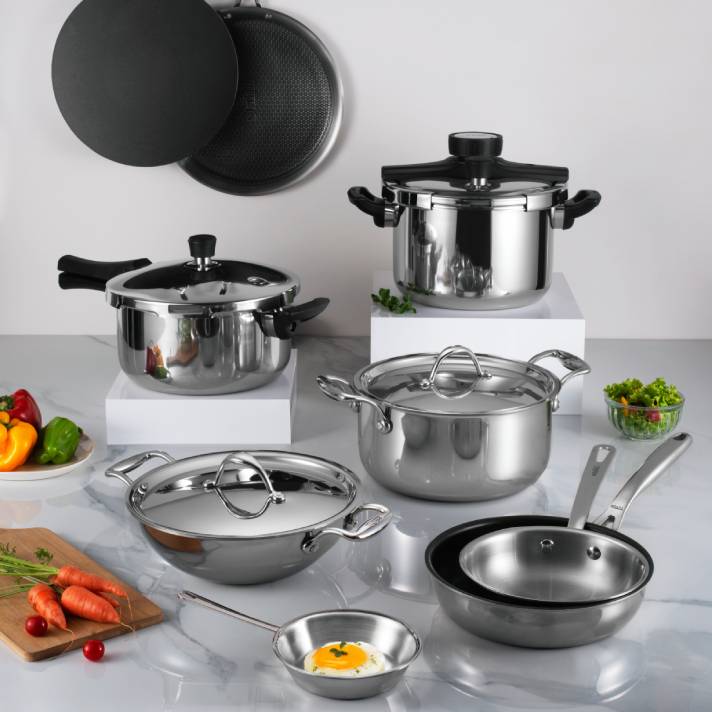Whether you’re a home cook experimenting with new recipes or a professional chef in a bustling kitchen, the cooking pan is your best companion. From frying eggs and sautéing vegetables to searing steaks and simmering sauces, cooking pans are an essential part of any kitchen. In this blog post, we’ll explore everything you need to know about cooking pans—the different types, materials, uses, care tips, and how to choose the right one for your needs.

What Is a Cooking Pan ?
A cooking pan, also known as a frying pan or skillet, is a flat-bottomed pan used for frying, searing, browning, and sautéing foods. Unlike pots, which have higher sides and are suitable for boiling or making soups and stews, pans have lower, sloped sides which make flipping and stirring food much easier.
Types of Cooking Pans
There are several types of cooking pans, each designed for a specific cooking style or dish:
1. Frying Pan / Skillet
The most commonly used pan in any kitchen, frying pans have slightly sloped sides and come in various sizes. Ideal for frying eggs, sautéing vegetables, or searing meat.


2. Sauté Pan
Sauté pans have straight sides and a larger surface area compared to a frying pan. They are excellent for cooking sauces or dishes that involve a lot of stirring, like risotto.
3. Grill Pan
Grill pans have ridges on the bottom that simulate the grill marks of an outdoor grill. Perfect for grilling meat and vegetables indoors.


4. Wok
Popular in Asian cuisine, woks have high, sloped sides and are great for stir-frying at high heat. The shape allows food to cook quickly and evenly.
5. Saucepan
While technically not a pan by the traditional definition, saucepans are used for cooking sauces and boiling small amounts of liquids. They usually have a long handle and a lid.


6. Crepe Pan
Crepe pans have very low sides and a completely flat surface, making it easy to spread batter thinly and flip crepes or pancakes.
7. Omelette Pan
Omelette pans are non-stick and usually have a slightly rounded bottom to help shape and flip omelets without tearing them.

Materials Used in Cooking Pans
The material of a cooking pan significantly affects heat conductivity, durability, and maintenance. Here are some common materials:
1. Stainless Steel
- Pros: Durable, non-reactive, resistant to rust and corrosion.
- Cons: Poor heat conductivity unless bonded with other metals like aluminum or copper.
- Best for: Searing, browning, and making sauces.
2. Cast Iron
- Pros: Excellent heat retention, ideal for high-heat cooking.
- Cons: Heavy, requires seasoning, can rust if not maintained properly.
- Best for: Frying, baking, and slow-cooked dishes.
3. Non-stick (Teflon or Ceramic)
- Pros: Easy to clean, requires little to no oil.
- Cons: Coating can wear off over time, not suitable for high heat.
- Best for: Eggs, pancakes, and delicate foods.
4. Aluminum
- Pros: Lightweight, good heat conductor, affordable.
- Cons: Can warp at high temperatures, reactive with acidic foods unless anodized.
- Best for: Everyday frying and sautéing.
5. Copper
- Pros: Excellent heat conductivity and responsiveness.
- Cons: Expensive, requires regular polishing, can react with acidic foods.
- Best for: Precision cooking and candy making.
How to Choose the Right Cooking Pan
When choosing a cooking pan, consider the following factors:
1. Purpose
Think about what you’ll be cooking most often. For general frying, a non-stick skillet works well. If you’re into high-temperature searing, opt for stainless steel or cast iron.
2. Size
Cooking pans typically come in sizes like 8-inch, 10-inch, or 12-inch. An 8-inch pan is great for solo meals or eggs, while a 12-inch pan is ideal for family-sized dishes.
3. Weight
A heavier pan generally retains heat better, but it should still be comfortable to handle.
4. Compatibility
Check if the pan is compatible with your stovetop—especially if you’re using induction burners. Many pans are labeled as “induction-compatible” on the packaging.
5. Oven Safety
If you plan on using the pan in the oven, ensure it’s oven-safe. Cast iron and stainless steel are great options here, while many non-stick pans are limited by lower temperature tolerance.

Cooking Pan Care Tips
To prolong the life of your cooking pans:
- Avoid metal utensils on non-stick pans to prevent scratching.
- Season cast iron pans regularly to maintain their non-stick surface and prevent rust.
- Hand wash pans when possible, especially non-stick and cast iron varieties.
- Dry thoroughly to prevent rust and corrosion.
- Store properly—either hang your pans or stack them with protective layers in between.
Benefits of Using the Right Cooking Pan
Using the right cooking pan can:
- Improve the taste and texture of your dishes.
- Make cooking more efficient by reducing sticking and uneven cooking.
- Ensure better control over temperature and doneness.
- Enhance safety by preventing burns or spills.

Conclusion
A good cooking pan is a foundational kitchen tool that impacts your daily cooking experience. Whether you’re flipping a pancake or searing a steak, the right pan can make a world of difference. By understanding the various types, materials, and maintenance techniques, you’ll be able to choose the perfect pan that fits your cooking style and needs.
Cooking is an art, and your pan is your brush—so choose wisely, care for it well, and let your culinary creativity flourish.




